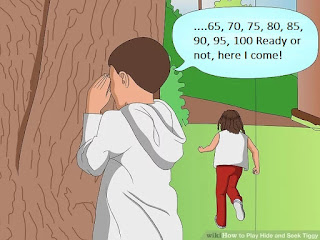 |
| Kham bak chieu or hide-and-seek. Adapted from Wikihow graphics |
Mata chat
In mata chat (cops and robbers) we had two teams that were picked via a ritual using two 14-syllable Hokkien rhymes. The selection process started with forming a circle. A leader would start to chant “chui lo chui lo, chui peng peng, chui chui chiak pah cho lang peng” (to select a mata or cop although the peng meant soldier). He would begin the first syllable by pointing to someone and moved to next person with each consecutive term. Somewhat like musical chairs, the person who ended up with the 14th syllable (say, peng) became the cop. To pick a chat or robber, we recited “chui lo chui lo, chui chat chat, chui chui chiak pah cho lang chat”. This would go on until two teams were selected.
There was little correlation between these rhymes, well-known for their fun, frivolity and humour, and the game itself. Roughly translated, the sayings ended with “whoever has eaten a full meal became a cop or a robber”. I had forgotten all about them until I was reminded by Kay Liang and Ong Seng Huat.
Each team had a set of objectives:
- The mata had a station where they kept all the chat they had caught. Their aim was to chase and catch as many robbers as possible and keep them at the station — it could be by a wall or at a porch for cars. In our case, the wall of the secondary school workshop facing the field served us well; it was strategic and provided some shade from the afternoon sun.
- The chat, on the other hand, aimed to avoid being caught. They also tried to rescue their comrades from the station. A mere touch of hands by a free team mate allowed any captured chat to run off.
Chiak bak (literally “consume meat” or, more generally, “inflict pain on the flesh”)
This sado-masochistic game, which could involve groups of 20 to 30, needed only a tennis ball – hard enough to inflict pain but not terribly harmful if we did not hit sensitive parts of the body like our eyes. The objective was straightforward: When you got the ball in your hands, re-direct it at another, to hit him as hard as possible.
The game started with a boy throwing the ball into the air, to be caught by another who would then try to hit someone else. Once you caught the ball, you cannot chase after others with it. One of the most dangerous situations was to find yourself right next to person who had caught the ball. You could try to wrestle the ball from him or curl up like a ball [sic] on the ground and take a hit.
Kar Keat remembers a tactic in which a group would pakat (make a pact): “It was used normally by a small group to bully others. They would form a pact prior to the start. In the game, they would fan out among the crowd of players. When one member got the ball, he would toss it to a partner who was in close proximity to another to cause maximum damage. Many a time they targeted people they wanted to bully.”
On rainy days, when the grounds were moist and muddy, the tennis ball soaked a lot of moisture, resulting in 3-4in mud marks on our white school shirts. It was a sure way of getting a scathing response from our parents when we got home.
Kham bak chieu
The basic kham bak chieu (literally “closed eyes” or, in English, hide-and-seek) was simple. One person closed his or her eyes leaning against a spot on a wall or tree, and counted — sometimes in multiples of five (5, 10, 15 and so on) to, say, 100. In the meantime, the others, which could number more than 10, went into hiding. Upon finishing counting, the “seeker” went around to look for the “hiders”. The moment anyone was spotted, there would be a race back to the counting position. In this way, groups of winners or losers were separated out. Finally, one of the losers would be chosen to be the next seeker. The selection process could involve lalalilatampong or one-two som! (these will be the subject of another story).
Another name of the game was ah chi lok. If I recall correctly, there was a slight variation in the version we played in our community; it involved a chase where the seeker had to chase and grab hold of a hider to pick the next person to seek. Like other traditional games, we could vary the rules as we we went along so it was not unusual to find differences among groups of players.
At home, we had the night-time variation that scared the seekers out of their wits. There were two instances that I remember very well: (1) Under the camouflage of darkness, some of the hiders would gang up and rush to the counting station in a group and left the seeker aghast at the mob rushing out (2) A darkish friend of mine, wearing dark shorts, decided to remove his white T-shirt. It was almost impossible to spot him until he was 20ft away, by which time it was too late for the seeker, caught off guard and shocked, to race back.
© Lim Siang Jin
No comments:
Post a Comment